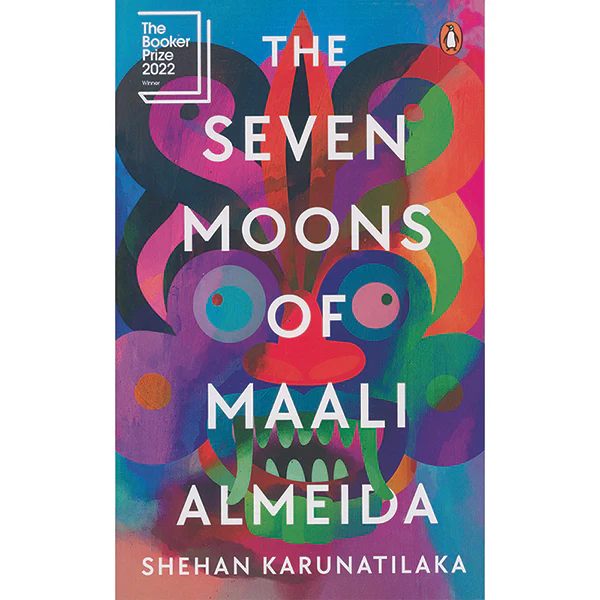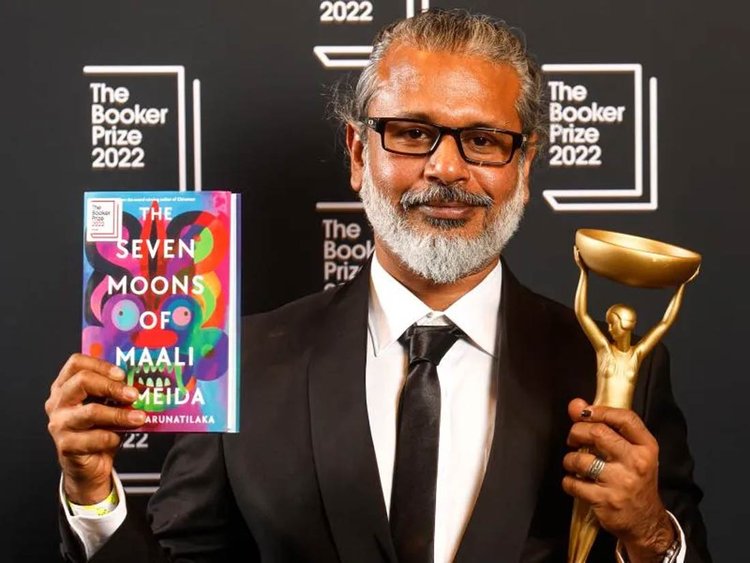Published September 23rd, 2024
Review
by Lisa Schantl
The Seven Moons of Maali Almeida (Sort of Books, 2022) is the second book by Shehan Karunatilaka, a writer and musician born in Sri Lanka, educated in New Zealand, and turned into a global citizen through residencies in London, Amsterdam and Singapore. The Booker Prize 2022 winning novel is — alike his previous publication Chinaman (self-published, 2010) — set in his country of birth and could be described as a murder mystery, as a queer love tragedy as well as a political heist. The novel lives up to these tags as the reader learns of the final days of the living, and the first seven postpartum nights of photographer Maali Almeida, a multifaceted character with his heart in the right place (for most parts).
Disclaimer one: If you are looking for a book in which the author takes you by the hand, shows you around gently before setting you free to explore the wide yet calm waters of their imagination, then this might not be the right piece of writing for you. Karunatilaka lets go of the reader’s hand almost immediately, tossing them into the wild and conflicted landscape of Sri Lanka, its people and unspoken laws. He does so not only by taking on a rather unusual narrative perspective — the second person singular — but also by placing the focalizer, Maali Almeida, outside of the actual happenings. Almeida is caught in the so-called In Between, where he dwells after his sudden death at the age of 35. From this view, we set out on an intense journey with the ultimate goals to, first, find out who is responsible for Almeida’s death, and second, to set Almeida’s spirit free.
What might already sound like a challenging trip is further enriched by nuanced details about the political situation in Sri Lanka in the 1980s, in which the main character played his part as a journalistic and documentary photographer. In 1983, the conflict between the Sinhalese majority and the Tamil Tigers, who were seeking a separate state for their people in the Northern part of Sri Lanka, escalated. As a response to a deadly ambush by the Liberation Tigers of Tamil Eelam (LTTE), the ruling United National Party (UNP) launched massacres and pogroms in various parts of the country which left almost 6,000 Tamils killed and more than 250,000 displaced. A Civil War broke out which would last until 2009, when the government officially defeated the Tamil Tigers.

There is no black and white, no utterly good nor irrevocably evil in complicated conflicts such as the one described — a truth that we are taught from several angles in The Seven Moons of Maali Almeida. The most prominent one of these angles is represented by the character Maali Almeida himself. A gifted photographer who hangs his life upon the belief that his photographs could make a difference for the civilians caught in tragic combats and massacres, his actions in his personal life reveal his flaws and struggles. Moving in with the young woman Jakie, knowing that he cannot respond to her feelings for him as she would like him to, he soon falls in love with her roommate Dilan Dharmendran, short “DD,” who happens to be the son of the minister Stanley Dharmendran, the lone Tamil member of cabinet. The minister does not approve of their relationship and understands it to be “not natural,” revealing the continuous challenging situation for the queer community in the South-Asian state. Despite Almeida’s often-evoked assuring words to DD to take on the world together and his claims to be truthful to him, Almeida repeatedly falls for strange boys, picking them up on his photo jobs or in one of hist most frequented places, the casino, and he leaves DD’s desire to leave Sri Lanka in vain.
Besides a complicated love story, the novel takes a plunge into the world of investigative journalism and the risks bound to such an undertaking. To earn money, which he is often quick to spend at the casino table, Almeida is hired by various newspapers and agencies to either capture the unspeakable scenes in war zones and combat or to lead journalists into these zones for first-hand insights, interviews and reports. Hardly any of his jobs are without risk, and some of the described scenes in the book can be upsetting and leave you gasping for air in face of the witnessed atrocities. Shehan Karunatilaka quickly reveals himself as an author who will not brighten up a dark moment or make something appear less tragic than it is. Disclaimer two: Readers should be prepared for unsettling violent encounters and multi-sensual illustrations of the downsides of human nature.
The book’s specialty amidst the various themes and historical depths that it deals with undoubtedly is its narrative perspective. The story time covers the first seven moons, or nights, after the protagonist’s death, enriched with a variety of lengthy flashbacks to Almeida’s past life. Everything is mediated through Almeida’s eyes, relayed in second person and from the In Between, that is, the first stage in the Afterlife before Almeida can go into The Light — if he chooses to do so. In this stage, he is frequently tempted by evil in the figure of the Mahakali, the Hindu goddess of time and death, especially when he wants to interact with the living to rescue his photographs and his friends, amongst other things.
While Mahakali’s charge towards Almeida might account for some of the most fast-paced moments in the entire book and those in which the author’s craft reaches its peaks, Almeida’s contemplations about life, death, and the plentitude of meanings in-between add a further layer to the novel. These contemplations often appear in the form of conversations with other spirits or figures in white robes who serve to guide spirits into The Light. Topics such as the existence and the will of a God or Gods, what happens to us after death, and what it takes to fight for a cause, cue readers to make up their own minds about a meaningful life, and the risks we might need to take to make it come true.
“There are only two gods worth worshipping. Chance and electricity.” (quote preceding the novel)
The Financial Times have earlier described the novel as “breathtakingly kaleidoscopic,” and I can only strengthen this ascription. Due to the position of the focalizer in the afterlife, Almeida’s life does not come as a straight line, and due to the narrator being Almeida himself, bits and pieces are left out, over-emphasized, or possibly blurred and altered in retrospect. Thus, here comes my third disclaimer for potential readers: If you prefer a book at the end of which you will feel like you understood it all, you know the characters, and you can draw a neat plotline, then this book might not be the right one for you. When I picked the book up for the first time, I was looking for such a straightforward story. Only a few pages in, I had to let the book rest for a few days before picking it up again — and then I could not let go anymore. You have to be ready for a ride that will be anything but predictable. Yet, once you’ve settled in the wildness of it all, you will be hooked and eagerly turn every page awaiting yet another surprise.

Karunatilaka provides his readers with some sort of structure to hold on to, however loose it might be. This structure appears in the form of chapters and chapter quotes as well as subtitles within the chapters. Each of the seven moons has its own chapter, which makes it easier to follow the actual progression of events that take place past Almeida’s death. “The Light” is an additional chapter at the end, serving as a resolution. The quotes that the author chose for each of these chapters to set the mood are an interesting assembly of various authors and media, including an excerpt from the Bible and a post on Twitter. Their meanings only relate loosely to the actual contents of the following passages, but they can be a tangible lifeline if the story becomes too intense and you need a breather once in a while.
A book as wide, and deep, and intense as The Seven Moons of Maali Almeida by Sheehan Karunatilaka is hard to summarize in one sentence, one paragraph, one review. I recommend giving this work a read if you are looking for something else, for new perspectives and different questions. I recommend picking it up if you are interested in Sri Lanka, in tough political realities, in journalism, or in ideas on the afterlife. And I do encourage you to give this book a second or a third try if you do not feel comfortable with it from the start. Published by an independent, rather small-scale UK publisher, this is the rare occasion that we have the chance to find “something else” in a Booker Prize winner. I almost dare to guarantee that you will cherish this one of a kind specimen.
Nationality: Austrian
First Language(s): German
Second Language(s):
English,
French,
Spanish
Supported by:

